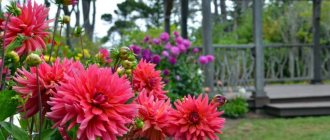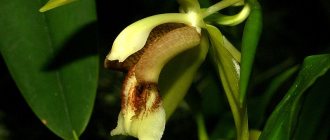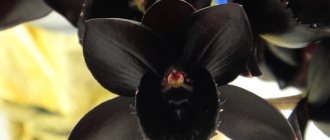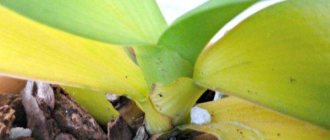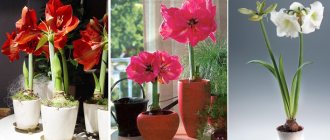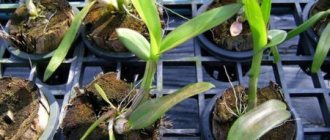Distinctive characteristics
Distinctive features of the Tselogina orchid, which belongs to the sympodial orchids:
- Short roots.
- Pseudobulbs are round in shape, about 5 cm in size. They produce one peduncle and a pair of leaves.
- The leaves are linear, with a glossy tint, dark green, cut with a fold. About 30 cm long.
- Flowers are up to 10 cm in diameter, have five petals, and a wide lower lip. They come in white, light yellow, light green and cream colors, often with patches of purple.
Pandurata
This species is distinguished by elongated pseudobulbs 8-10 centimeters long. Belt-shaped leaf plates reach 45 centimeters in length. The peduncle contains a large number of creamy-green flowers, and the lip is covered with beautiful brown and black spots.
Coelogina pandurata is thermophilic and blooms in early summer.
Tselogina Pandurata
Popular types: photos and descriptions
Cristata or comb (Cristata)
The pseudobulbs are round, the leaves are belt-like. The length of the peduncle is 30 cm. From 3 to 10 flowers are formed on it. The flowers are up to 8 cm in diameter, white, the three-lobed lip is orange-yellow.
In order for Kristata to delight with her flowering at home, she needs some care.
She prefers shady places with diffused light, high air humidity and good air exchange around the root system.
Fimbriata or fringed (Fimbriata)
Slightly flattened pseudobulbs are only about 3 cm in size. They are bifoliate, ovoid or elliptical in shape. Leaves are linear. The peduncle reaches a length of 5 cm, and the size of the flowers is 3 cm. The lip is triple and covered with fringe. The petals have a light-yellow tint, and the lip is decorated with cherry-colored patterns.
Asperata
The shape of closely spaced pseudobulbs is oval. Each peduncle produces 35 flowers. The flowers are large, 6.5-7.5 cm in size, with light green narrow petals and brown spots on the lip.
Rochusseni
Pseudobulbs are cylindrical in shape and produce two oval, pointed leaves. The flowers are lemon yellow. They emit a citrus aroma. The difference between the flowers is in the narrow-lanceolate and pointed sepals and petals. The lower lip of the flower is three-lobed.
Speciosa or beautiful (Speciosa)
The leaves are oblong, light green in color. The peduncles are short, with 1–2 buds appearing on them. The flowers are yellowish-green in color, have a wide lower lip, decorated with a yellow spot with red-brown streaks.
Flassida or drooping (Flaccida)
A plant with elongated pseudobulbs, long and drooping flower stalks. The leaves are bright green, lanceolate in shape. The lower lip of the flower is three-ridged and covered with bright yellow spots.
Ovalis or oval (Ovalis)
They are distinguished by their spindle-shaped pseudobulbs. Leaves are rich green. The color of the flowers is yellow-green. Brown veins are visible on the lower lip.
Miniata
Blooms in winter. Each peduncle bears four buds 2.5 cm wide. The color is beige or bright orange. Canine bulbs are brown in color and ovoid in shape.
Miniata is quite capricious in care and in order for new flower stalks to appear, it is necessary to create certain conditions for the plant.
Bearded (Barbata)
The shape of the bulbs is almost round, the color is light green. They are distinguished by elongated lanceolate leaves. The sepals and petals of the flower are elongated and white. The lower lip is greyish-brown and decorated with fringe.
Massangeana
Large bulbs. Veins stand out on long leaves. About 20 cream-colored flowers are formed on the flower-bearing arrow. The lower lip is three-lobed, ocher-colored, decorated with a yellow spot.
Mooreana
The height of an adult plant is about 40 cm. The pseudobulbs are ovoid in shape. Oval-lanceolate leaves with a glossy sheen. The flowers are snow-white. The edges of the petals are pointed. The lower lip is covered with a scattering of orange-golden spots.
Pandurata
The leaves are belt-shaped, with folds. The bulbs are oblong. The flowers are large, with creamy-green sepals. The wide lip is decorated with fringed combs and covered with spots of brown and black.
Usita (Usitana)
The bulbs are elongated. The light green leaves have noticeable veins. Each peduncle produces about 20 cream or greenish flowers. The lip is dark brown.
fringed
Coelogina fringe is native to the tropical forests of Vietnam, southern China and India. The miniature flower loves warmth and needs plenty of light.
The maximum height of the pseudobulb, which contains several leaflets, is 2-3 cm.
The peduncles contain 1-3 miniature flowers with a diameter of up to 3 cm. Their color is yellowish-green. There is a brownish-burgundy pattern at the bottom of the lip.
Flowering occurs from August to October. In the autumn, celogina delights those around with its light green color and unusual cherry patterns on the lower lip. Finding a flower on sale is quite difficult.
In the photo below is the variety Tselogina Fringed:
Coelogina fringed
Home care
Temperature and ventilation
The temperature conditions are different, depending on the type of plant:
- hot (20–30 °C, with a difference in day and night temperatures of up to 2–3 °C);
- relatively cool (15–20 °C, with a difference of 5–7 °C);
- cool (15–20 °C, with a difference of up to 10 °C).
Throughout the warm period, celogina can be kept outdoors, but drafts should be avoided.
Lighting and location
Prefers diffused light; in winter it is necessary to use additional lighting. It should be remembered that direct sunlight harms the plant. The optimal location is window sills facing east or west.
Read here which artificial lighting to choose for a plant from autumn to spring.
Humidity and watering
Celogina needs a high level of humidity - 70–85%. It is recommended to install the plant in a tray filled with water.
Flowering and dormant period
It grows actively from early summer to early autumn. The end of September - beginning of October is a period of relative calm. Then the plant blooms until March, after which a dormant period of 15–20 days begins again.
Soil and planting capacity
The optimal soil should consist of well-seasoned pine bark, charcoal, decomposed sheet compost, sphagnum moss, perlite, expanded clay or polystyrene foam. The capacity depends on the type of orchid. These can be blocks made from pine bark, wide and low flower pots with drainage holes, plastic baskets with slits and holes.
The video shows how to make a substrate for celogina and which container is best to choose:
Fertilizers and fertilizing
Fertilize the plant with products designed specifically for orchid species. Feeding is carried out when the pseudobulbs begin their growth period.
During the resting stage, the orchid is not disturbed.
Transfer
Transplanting celogina is quite easy:
- Clean the plant from the remains of the old substrate, rotted and damaged roots.
- Activated carbon in powder form is applied to the cut areas and left to dry.
- Lower the root part into a container filled with drainage made of inert materials, cover it with substrate, slightly compacting it. Covered with moss.
Check out the video about the transplant rules:
Reproduction
Propagated by dividing the rhizome:
- Divide the rhizome of an adult plant, leaving 3–4 pseudobulbs on each separated part.
- Treat the cut areas and dry them thoroughly.
- Planted in a container filled with moss, secured with wire.
- As soon as roots appear, increase the frequency of watering.
New orchids begin to bloom in the 2nd or 3rd year.
Celogina orchid: growing features
Meet an exotic flower in the Himalayan gorges, as well as on the coast of the Indian or Pacific Ocean. The subtropical/tropical climate in tandem with the impenetrable jungle creates excellent conditions for such “beauties.” Unfortunately, it is impossible to create a similar environment in your home or apartment. However, there is something that everyone can do.
Planting secrets
The first step to successfully planting a coelogina orchid is choosing a pot. It should be wide, but not deep, since the roots grow in breadth, not in depth. The best option is transparent containers. However, there must be holes both at the bottom and on the sides. Drainage must be placed at the bottom - a layer of expanded clay.
If a gardener buys a substrate in a store, then it is worth taking a fine-grained mixture. Most of it is pine bark. A useful ingredient would be decomposed leaf compost.
For the celogina orchid, loose, light and porous soil is created that is capable of retaining moisture for a long time. Below are options for such compositions:
- A mandatory element is pine bark. The maximum fraction size is 1 cm.
- The disinfectant component is charcoal. Some add it crushed, while others add it in pieces.
- The loose base consists of sphagnum moss or coconut fiber. You can also experiment with foam. It is taken as much as all the other parts.
- Fertilizers. Peat soil (up to 15-20%, because it burns the roots), crushed fern roots or leaf compost will serve as an excellent top dressing.
Still, there are varieties that have very long roots (coelogyne fimbriata, which means fringed). Therefore, they are advised to be grown on top of special blocks. The rhizome is fixed to the pine bark with a wire. The resulting object is wrapped in a dense layer of sphagnum moss. As a result, you will have to water and spray the specimen more often than usual.
Subtleties of reproduction
The root system of the flowerpot should not be disturbed too often. It is better to do this once every 3 years. Sometimes events are carried out in extreme cases:
- presence of diseases or pests;
- the time has come to divide the bush;
- replacement of depleted substrate.
When the bush has grown too much and the young shoots are far beyond the container, then the orchid is ready for replanting. Propagation of the crop is carried out by dividing the rhizomes. The basic principle of the process: each new seedling should have both young and old pseudobulbs (2-3 pieces). At the same time, it is important to inspect the root system so that it is well developed.
Spray the flowerpot very carefully, preferably over the moss, so that moisture does not collect in the middle of the bush. In summer, the procedure is repeated 2 times a day.
Next, prepare the soil mixture: high-quality bark, coconut fiber and sphagnum. Expanded clay is laid at the bottom. After which they follow the basic rules of how to plant an orchid. The following method is used:
- remove the flowerpot from the pot;
- remove the old substrate;
- remove dead roots;
- cut the bush into pieces with a sterile blade so that there are no lacerations;
- the sections are sprinkled with crushed carbon (activated or charcoal);
- seated in separate containers;
- fixed for stability.
Further care largely depends on the degree of development of the seedling. It will need moderate watering at first. With the appearance of new roots, the soil is moistened much more often and sprayed regularly.
Place a reservoir of water next to the flowerpot so that the humidity is at least 50%. The above measures will be successful if changes in the development of the mountain plant are noticed in time.
Diseases and pests
Fungal diseases
The cause is lack of proper care or inappropriate growing conditions. They get rid of the fungus using fungicidal drugs.
Read more about orchid diseases, how to recognize and treat them here.
Spider mite
The best way to combat it is to place the plant under a warm shower and wipe all areas of the flower. It is undesirable to use chemicals. If necessary, they should be used with great caution. Read more about the fight against mites on orchids here.
Reproduction
By division
It is customary to propagate the coelogina orchid by division.
Due to the rapid formation of daughter plants, the crop can be divided during each transplant. However, it is not recommended to carry out such a procedure too often, which is associated with the increased sensitivity of the roots to damage. There is no need to distribute the flowers into separate containers: the celogina is divided in such a way that strong and large “groups” of 4-5 pseudobulbs can ensure abundant flowering.
The division procedure is practiced in the spring with special care. To cut pseudobulbs, a sharp device is used, with the help of which the bush is carefully divided into 2-3 parts.
Traces of injuries and damage require treatment with crushed coal.
Possible growing problems and causes
Decay of pseudobulbs
Occurs due to waterlogging of the substrate, contact with wet moss, or improper replanting. It is necessary to cut off the rotten parts, treat the cuts with a fungicide and transplant the plant into a substrate with less moisture.
Leaves wither
If hard water is used for irrigation or the soil is too saline, the tips of the leaves begin to dry out and die. It is necessary to replace the soil and water for irrigation.
Spots on leaves
The appearance of brown or black spots occurs due to sunburn, exposure to too dry air, and elevated temperatures. The conditions of detention should be adjusted.
Fimbriata
The group includes lithophytic and epiphytic orchids with compact ovoid pseudobulbs 3-4 cm long, colored light green. At the top of each pseudobulb there are 2 narrow lanceolate green or glossy leaves up to 9 cm long, planted on long petioles.
Thin peduncles have a delicate flower at the top. The diameter of the flowers is 3 cm. They are distinguished by a yellowish or creamy tint, as well as triangular petals.
Coelogina Fimbriata
Transplantation of cellulum, containers and substrate
Active growth, constant expansion and increase in the size of the “family” of celogina, a large number of daughter plants require fairly frequent replanting. It should be carried out only as needed - when all the space in the pots is completely filled, but this process should not be delayed. During transplantation, it is preferable not to separate the families, especially if the maximum diameter of the containers has not been reached.
Transplanted coelogins. fedorchids
For celogina, the usual substrate for growing orchids is perfect - coarse, high-quality soil with an optimal ratio of bark, fern fibers, sphagnum and with the addition of coal. Coelogins love mulching, covering the substrate with sphagnum or decorative mosses to maintain stable humidity.
Coelogina fringed and beautiful are sometimes sold as epiphytes mounted on decorative and cork blocks, but any species feels much better in low but wide baskets and containers from among the typical containers for orchids with holes for free air circulation.
The plant is carefully handled, the old soil is removed only if there are signs of fungal disease. It is advisable to place drainage and large heavy stones at the bottom of the container, which increase the stability of the orchid. If the old container is heavily entwined with roots, it is better to plant the entire orchid in a new container along with the old basket.
What does celogina look like?
Despite their abundant flowering, coelogins could never compete in popularity not only with phalaenopsis and dendrobiums, but also with vandas or cattleyas.
This is not the most common, but definitely a special plant of the Orchid family; it differs pleasantly from its indoor competitors in both its unpretentiousness and the duration of flowering. But the main “trump card” of coelogin is the number of flowers. Growing rapidly and pleasantly surprising with blooming clouds, this orchid certainly claims to be one of the most graceful soloists.
Among gardeners, coelogines are also known as “bride orchids”, “white fairies”, “snow cloud”, and Hololeika. This orchid is easy to distinguish against the background of phalaenopsis and other indoor orchids by its drooping peduncles and numerous snow-white flowers.
Coelogines are sympodial orchids with short roots, whose elongated pseudobulbs are surprising in their round shape and compact size (on average up to 5 cm in length). They produce only a couple of sessile leaves.
Coelogines cannot compete with the more popular orchids in terms of showiness and size, but due to the fact that plants are never grown one at a time and create colonies, the greenery of coelogines makes a vivid impression, and the plant itself looks impressive. Linear, with a prominent fold, glossy, dark green leaves of celogina look elegant even when the plants are not blooming. The leaves do not exceed 30 cm in length.
The flowering of celogina is one of the most luxuriant among indoor orchids. Peduncles grow from the base of the pseudobulbs, powerful and strong, they are crowned with a brush of inflorescence consisting of 5-7 pedicels and buds. After blooming, the flowers grow up to 9 cm in diameter, their rare arrangement allows you to appreciate the beauty of each individual flower, but at the same time, the plant seems to be covered with a huge continuous cloud of flowers.
Each pseudobulb produces only one peduncle, but the whole family of coelogines produces an astonishing number of peduncles at the same time, and the number of simultaneously blooming flowers is measured in the dozens. Long, sparse drooping brushes are very beautiful.
The structure of the coelogina flower is very elegant. The lower three-lobed lip, pointed petals, original waviness and outgrowths similar to small “brushes” - everything in this orchid evokes thoughts of tenderness.
Coelogina orchid. Eerika Schulz
The color scheme of coelogines is quite boring, if one can say so about the impeccable snow-white color of most coelogines. Snow-white, shining, as if glowing, thanks to the texture of the petals, the color is only emphasized by the yellowish-orange outgrowths and “colored” details on the lip. Less common are cream and yellow-green species. Cologins also pleasantly surprise with their delicate aroma.
The flowering period of celogina adorns the first half of the calendar year. Traditionally, this orchid blooms only in the middle of winter and offers you to enjoy the beauty of its white inflorescences until the first spring stars come into their own.
Flowering of the celogina from January to April is typical, but often the orchid pleases at completely different times, sometimes from March or April to mid-summer. It all depends on the conditions and habits of the plant itself: how the cycle was built in the flower center, and how the temperatures and lighting in a particular house change as the seasons change.
Fertilizer
During the growth of pseudobulbs (after flowering), add special fertilizers for orchids to the water every other time, skipping one watering. After the pseudobulbs grow, fertilize after 2 waterings. Do not fertilize the plants during the dormant period! Some coelogina orchids can reproduce pseudobulbs outside the pot. In this case, young shoots imitate aerial roots. They must be sprayed every day until the next transplant.
In winter, before flowering, which occurs in early spring, c. comb needs a long period of rest, during which it is necessary to stop watering. Keep the orchid at a temperature of 10 ° C. When you notice that the pseudobulbs begin to become covered with wrinkles, resume your previous care.
external reference
- Wikimedia Commons has a media gallery about Coelogyne
. - Photo of Coelogyne assamica
- Coelogyne barbata photo
- https://orchids.wikia.com/wiki/Coelogin
| authoritative control |
|
- Data: Q2206870
- Multimedia: Celogon
- Type: coelogyn
Pruning and watering
After the flower withers, cut the peduncle as low as possible: at the very pseudobulb from which it grows.
For heat-loving coelogines, the substrate should be constantly moist throughout the year, and for the rest, from April to September. During extreme heat, watering can be daily. Fill the pot with a volume of water that is equivalent to the volume of the pot. After 1-2 hours, drain the pan of water that has flowed out of the pot. In winter, when the new pseudobulbs reach the same size as the old ones, allow the substrate to dry out between two waterings. This does not apply to orchids, which prefer warm conditions.
Transfer
Every 3 years (maximum), when pseudobulbs form, carefully remove the orchid from the pot. Also carefully free the roots from any remaining substrate. Wait until the new pseudobulbs have already formed so as not to confuse them with flowering shoots.
Both pseudobulbs and stems appear in the same place and at first are very similar to each other. Rinse the roots with water. Remove broken, diseased and rotten ones. Also remove dry pseudobulbs. Use clean and disinfected pruning shears.
The roots of this orchid are very short. To guide their growth into the substrate, take 2 or 3 segments of medium-diameter 20 cm long iron wire and bend them into the shape of hairpins. Press the rhizome onto the substrate using these “pins”.
Coelogina orchids do not like transplanting. Do this only when the substrate has become almost dusty, or when there are a lot of new shoots and the plant has become too large. For replanting, choose a pot that is much larger than the previous one, so that you do not have to disturb the flower over the next few years.
Choose a pot whose diameter is 3-5 cm larger than the diameter of the previous pot. Add a few centimeters of moist substrate (see plate below). Plant the plant so that the base of the pseudobulbs is 2 cm below the edge of the pot. Place the part of the orchid that is opposite the new shoots against the edge of the pot. Plant pseudobulbs with aerial roots in the mixture.
The ideal substrate consists of 60% pine bark of the middle fraction, 20% expanded clay of the middle fraction and 20% sphagnum. Pre-moisten the mixture before planting.
Compact the substrate with a stick. Compact on the side opposite the plant to avoid damaging the roots and rhizome. After these manipulations, the base of the rhizome should remain flush with the surface of the substrate. Do not water the plant until new roots appear! From time to time, spray the surface of the substrate with decalcified water at room temperature from a spray bottle.
